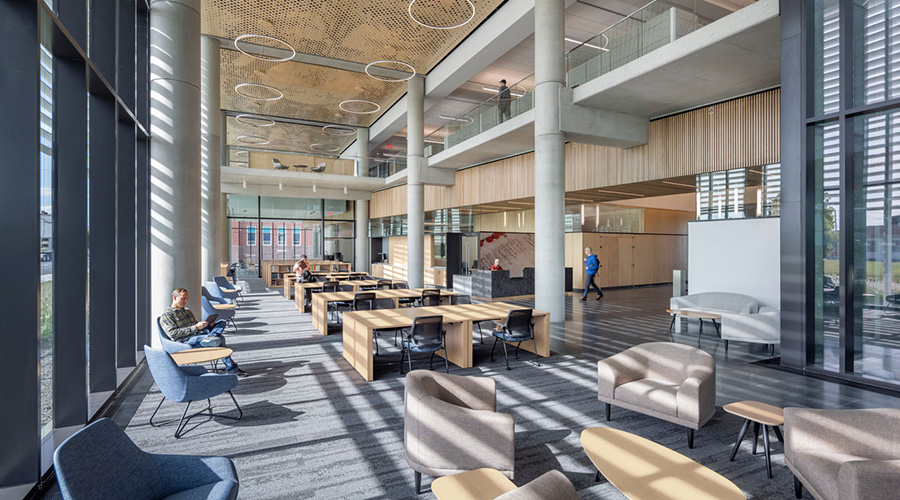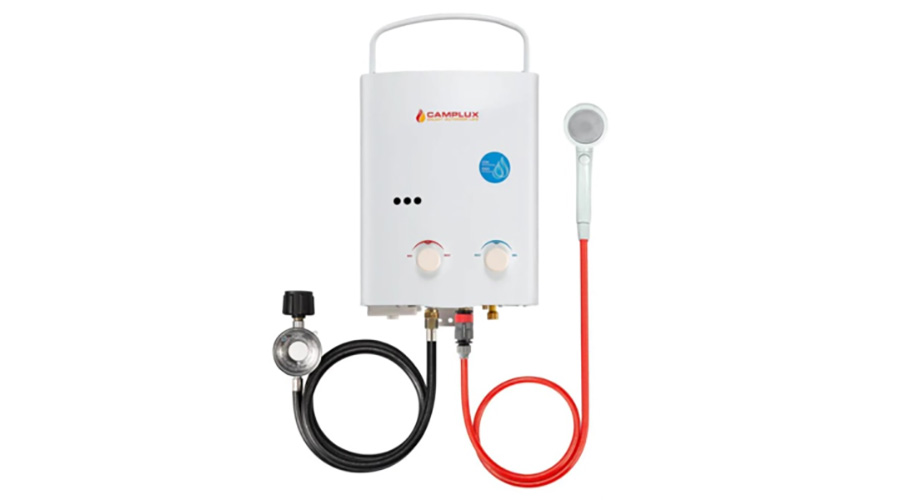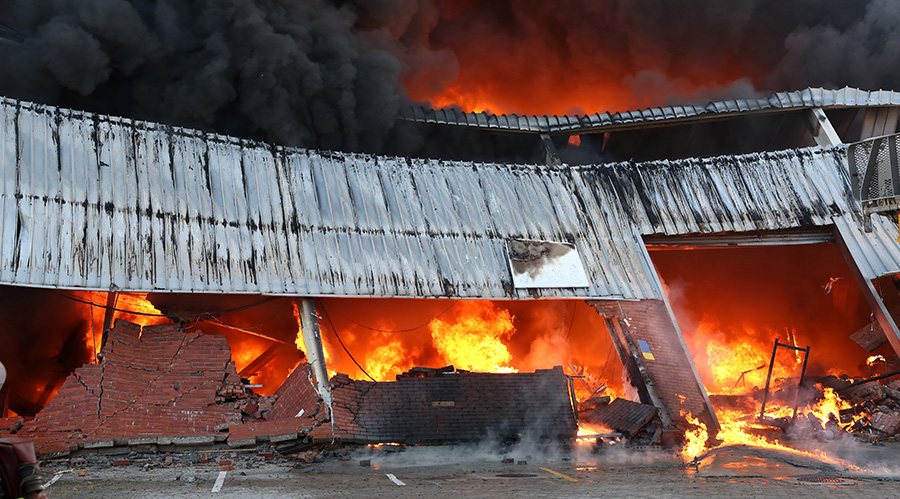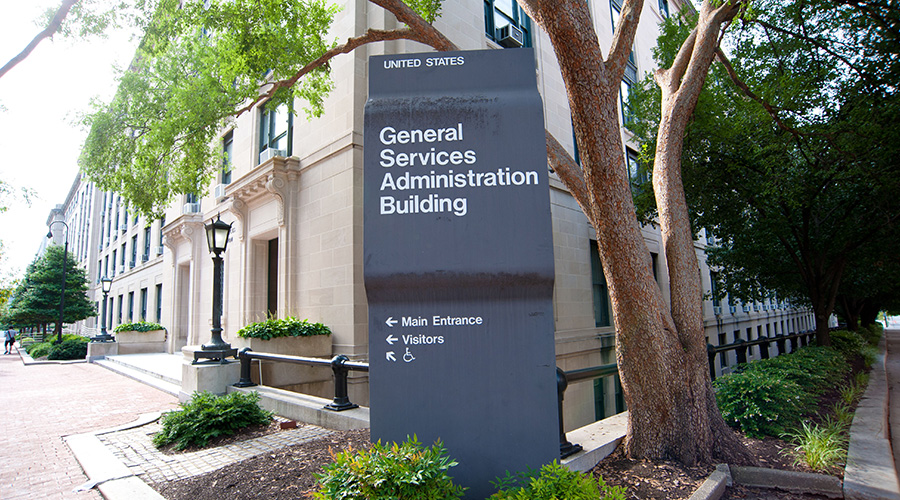
Albert Vecerka/Esto
HGA Completes Pennsylvania State Archives Project
The renovation project sourced many of its materials from Pennsylvania. March 15, 2024
National interdisciplinary design firm HGA completed the renovation of the Pennsylvania State Archives, located in Harrisburg, Pennsylvania. HGA partnered with Vitetta in the design of the new facility. Leading schematic design and design development, HGA also served as the engineers-of-record from beginning to end, providing structural, mechanical, electrical, and plumbing (MEP), including lighting design, audio/visual, and telecom/security.
Created in 1903 as the Division of Public Records, it became recognized as its own bureau upon joining the Pennsylvania Historical and Museum Commission (PHMC) in 1945. By 2000, its first permanent home in the Capitol Complex was reaching capacity and its low floor to floor height, together with a small floor plate, affected operational efficiency and would not allow for necessary environmental upgrades.
The new 146,000 square foot facility is recognized as a leader and top performer for state archives nationwide. Open to the public four days a week, documents are available for viewing, either digitally in the Main Reading Room or directly in person in the Original Documents Room. The Archives’ collection dates to the Pennsylvania Charter of 1681, extends through pre- and post-revolutionary times and the founding of the nation, and on to the present. More than 300 million letters, disquisitions, photographs, maps, and other records of note are stored at the Archives.
Visitors are invited to stay as long as they wish and are offered several amenities, including computers, scanners, printers, a kitchenette with seating, lockers, a meeting room, a classroom, an interactive video wall, gallery, and all-gender restrooms, all intended to provide a welcoming and comfortable environment.
To stay close to the Capitol Complex, an urban site in a neglected neighborhood was selected for the new facility. Built amidst the few remaining rental row houses, light commercial, and the city’s rail yards, Pennsylvania State Archives is striving to have a positive impact on the neighborhood and city.
The building design fulfills the Archives’ mission – to collect, preserve and make all materials available to the public:
- Collections: A glazed-brick volume and high-thermal-mass concrete structure forms the body of the building, housing acid free boxes and flat-file maps on high density shelving. The rectangular volume is windowless, well insulated, and projective, presenting most of the building enclosure. Total storage on three floors is 47,000 square feet with space for growth, and the 12-foot-tall high-density shelving makes the collections rooms highly efficient. Archives’ storage rooms are tightly controlled to keep out all daylight
- Mechanical systems: A metal-clad mechanical bay links efficient HVAC systems to archive rooms on each floor providing tightly modulated temperature and humidity to each kind of environment and material, whether its paper, print photography, or film.
- Public space: A double-height glass and aluminum pavilion set in a public garden with native plants combines a place for individual and group research with a sense of openness and accessibility.
“We designed this state archives facility to securely protect and preserve Pennsylvania’s artifacts in perpetuity, while simultaneously offering an open, accessible and welcoming environment for visitors of all ages and backgrounds,” says Paul Neuhaus, project designer with HGA. “Visitors typically include individuals doing research on family ancestry, historians, academic researchers and the curious. The building’s amenities provide a welcome and comfortable stay.”
The Archives are designed to provide a climate resilient, durable, 50-to 100-year facility built to protect the archives while enduring extreme conditions. HGA worked closely with state archivists who expressed concern for the potential impacts of climate change on the collections as well as vulnerability to human-caused disasters.
Fifteen areas of concern included railroad accidents, extreme or intense precipitation, theft, pests, moisture/mold growth, extreme wind, excessive snow load, and power failure.
- Railroad yard disaster concern: A sensor was specified for the mechanical louvers that would shut down air intake if any harmful chemicals at elevated concentrations are detected.
- Extreme precipitation concern: No roof drains or roof penetrations are located over the archive rooms. Rain landing on the low slope roof runs down to roof drains over the mechanical rooms.
- Theft concern: Security from the facility includes cameras and restricted access to the Original Documents room where staff members monitor visitors’ movements. Staff entry and exit paths with security systems are choreographed as well, for additional security.
- Power failure: HGA negotiated with the electric utility company, Pennsylvania Power and Light, to get two points of electricity service – one primary and one backup, each arriving from a different buried feeder line path to the site. In addition, the facility includes a standby generator with 48 hours of fuel capacity.
Ash wood was used for all interior building woodwork. Now disappearing across the country due to the Emerald Ash Borer, the wood wall panels will one day illustrate the beauty of the once-common native tree. Additionally, the site’s original granite street curbs were used as planter curbs and boulders found buried there were used as landscaping features in the public garden. The stone for the exterior pavers and interior floors, and the front desk was quarried in the Appalachian Mountains, and the glazed brick was made in Pennsylvania.
“We expect that students and younger researchers will arrive and discover the interactive video wall, exhibits in the gallery and relatable documents including maps, photographs and letters, shared to familiarize students and inspire future researchers,” says David Carmicheal, director of the Pennsylvania State Archives.
Next
Read next on FacilitiesNet












